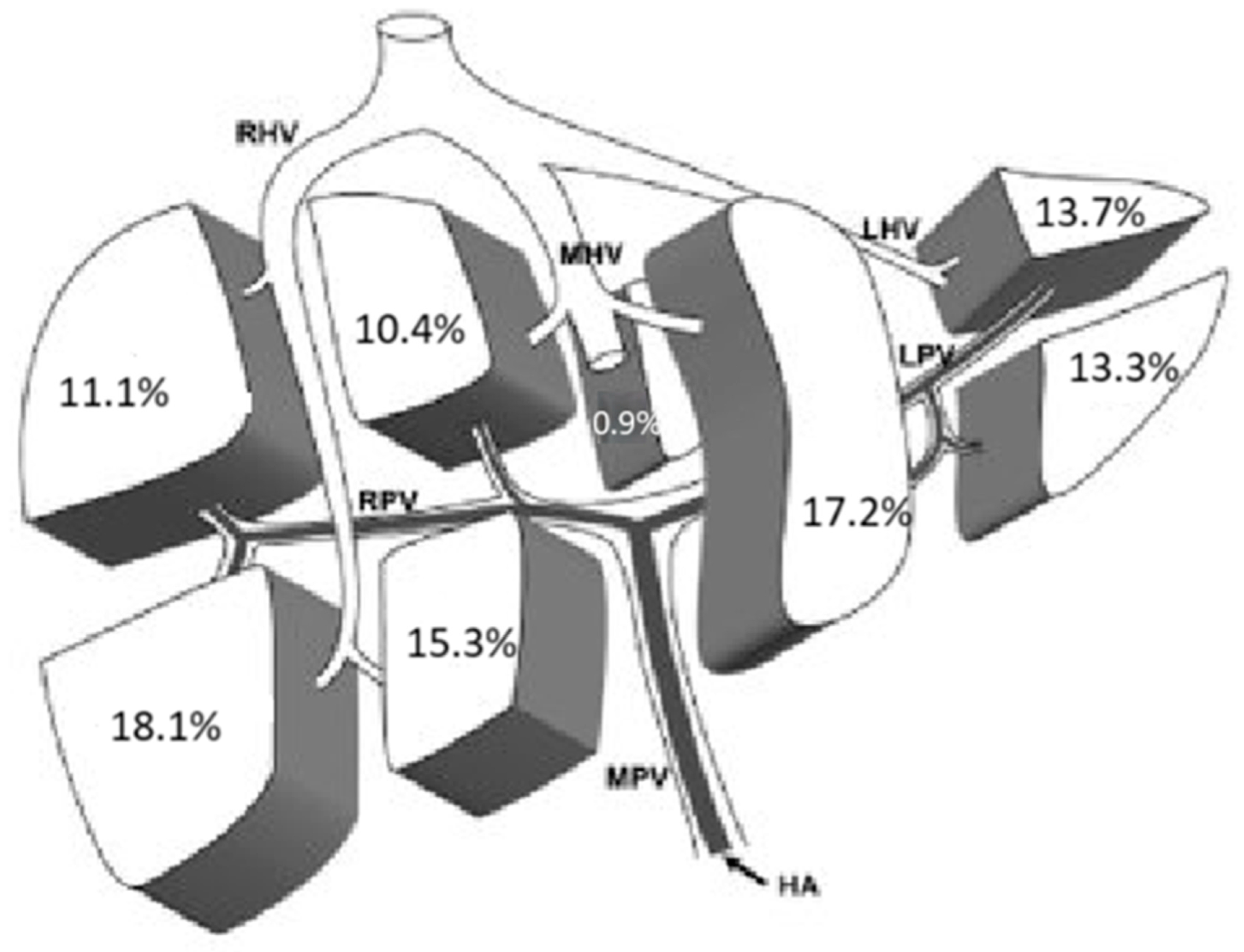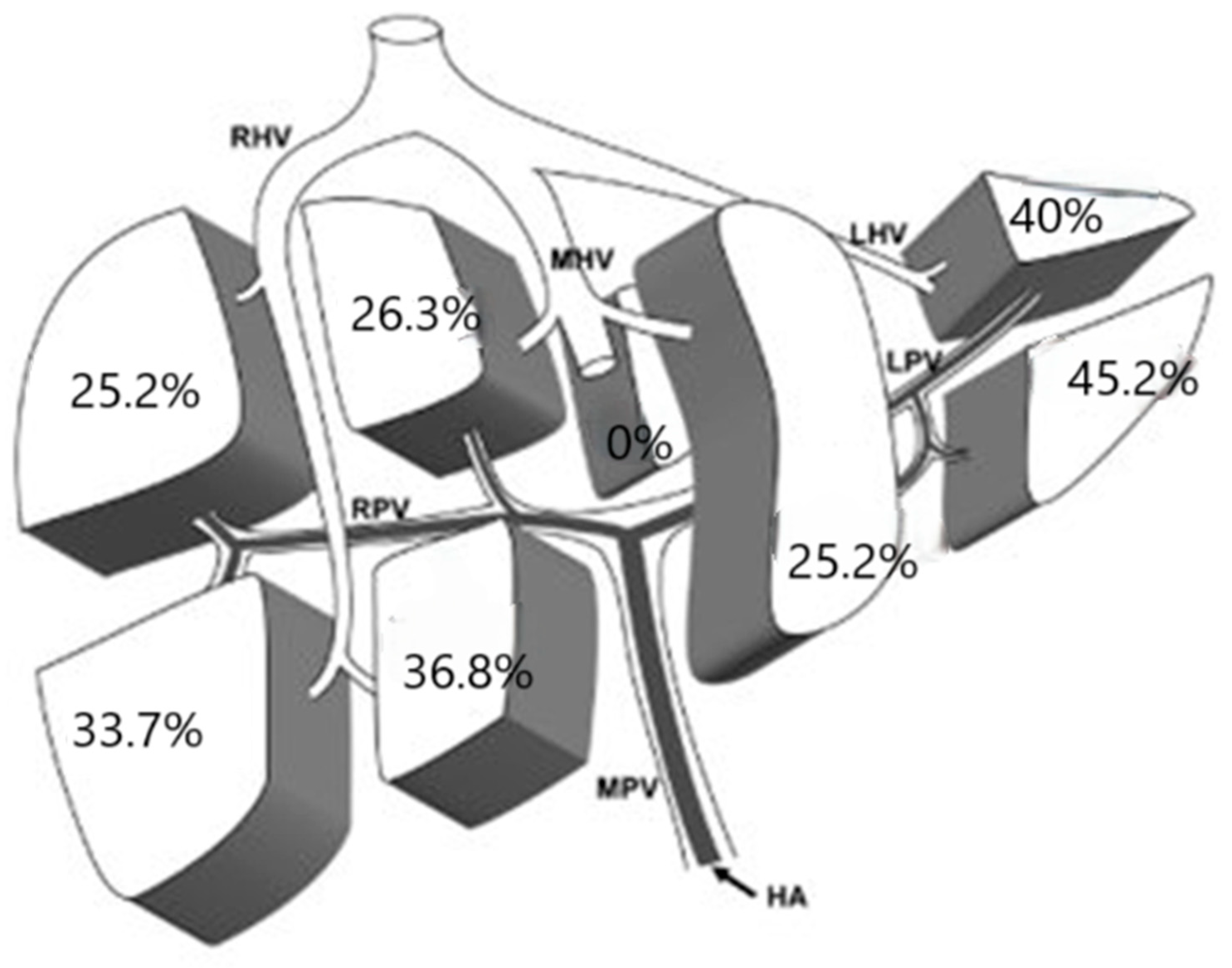Robotic Liver Resection for Hepatocellular Carcinoma: A Multicenter Case Series
Simple Summary
Abstract
1. Introduction
2. Materials and Methods
3. Results
4. Discussion
5. Limitations
6. Conclusions
Author Contributions
Funding
Institutional Review Board Statement
Informed Consent Statement
Data Availability Statement
Conflicts of Interest
References
- Buell, J.F.; Cherqui, D.; Geller, D.A.; O’rourke, N.; Iannitti, D.; Dagher, I.; Koffron, A.J.; Thomas, M.; Gayet, B.; Han, H.S.; et al. The International Position on Laparoscopic Liver Surgery. Ann. Surg. 2009, 250, 825–830. [Google Scholar] [CrossRef] [PubMed]
- Giulianotti, P.C.; Coratti, A.; Sbrana, F.; Addeo, P.; Bianco, F.M.; Buchs, N.C.; Annechiarico, M.; Benedetti, E. Robotic liver surgery: Results for 70 resections. Surgery 2010, 149, 29–39. [Google Scholar] [CrossRef] [PubMed]
- Bagante, F.; Spolverato, G.; Strasberg, S.M.; Gani, F.; Thompson, V.; Hall, B.L.; Bentrem, D.J.; Pitt, H.A.; Pawlik, T.M. Minimally Invasive vs. Open Hepatectomy: A Comparative Analysis of the National Surgical Quality Improvement Program Database. J. Gastrointest. Surg. 2016, 20, 1608–1617. [Google Scholar] [CrossRef]
- Tranchart, H.; Ceribelli, C.; Ferreti, S.; Dagher, I.; Patriti, A. Traditional versus robot-assisted full laparoscopic liver resection: A matched-pair comparative study. World J. Surg. 2014, 38, 2904–2909. [Google Scholar] [CrossRef]
- Croner, R.S.; Perrakis, A.; Hohenberger, W.; Brunner, M. Robotic liver surgery for minor hepatic resections: A comparison with laparoscopic and open standard procedures. Langenbecks Arch. Surg. 2016, 401, 707–714. [Google Scholar] [CrossRef] [PubMed]
- Pattilachan, T.M.; Christodoulou, M.; Ross, S.B.; Lingamaneni, G.; Rosemurgy, A.; Sucandy, I. Internal validation of the Tampa Robotic Difficulty Scoring System: Real-time assessment of the novel robotic scoring system in predicting clinical outcomes after hepatectomy. Surg. Endosc. 2024, 38, 7131–7138. [Google Scholar] [CrossRef]
- European Association for the Study of the Liver. EASL Clinical Practice Guidelines: Management of hepatocellular carcinoma. J. Hepatol. 2018, 69, 182–236. [Google Scholar] [CrossRef]
- Couinaud, C. Definition of Hepatic Anatomical Regions and Their Value During Hepatectomy (Author’s Transl). Chir. Mem. L’academie Chir. 1980, 106, 103–108. [Google Scholar]
- Clavien, P.A.; Barkun, J.; De Oliveira, M.L.; Vauthey, J.N.; Dindo, D.; Schulick, R.D.; De Santibañes, E.; Pekolj, J.; Slanka-menac, K.; Bassi, C.; et al. The Clavien-Dindo Classification of Surgical Complications: Five-Year Experience. Ann. Surg. 2009, 250, 187–196. [Google Scholar] [CrossRef] [PubMed]
- Maucort-Boulch, D.; de Martel, C.; Franceschi, S.; Plummer, M. Fraction and incidence of liver cancer attributable to hepatitis B and C viruses worldwide. Int. J. Cancer 2018, 142, 2471–2477. [Google Scholar] [CrossRef]
- Pang, Y.Y.; Strasberg, S.M. The Brisbane 2000 Terminology of Liver Anatomy and Resections. HPB 2000; 2:333–39. HPB 2002, 4, 99–100. [Google Scholar] [CrossRef] [PubMed]
- Cherqui, D. Laparoscopic liver resection. J. Br. Surg. 2003, 90, 644–646. [Google Scholar] [CrossRef] [PubMed]
- WHO. Definition of An Older or Elderly Person; World Health Organisation: Geneva, Switzerland, 2010. [Google Scholar]
- Charlson, M.E.; Pompei, P.; Ales, K.L.; MacKenzie, C.R. A new method of classifying prognostic comorbidity in longitudinal studies: Development and validation. J. Chronic Dis. 1987, 40, 373–383. [Google Scholar] [CrossRef] [PubMed]
- Ferrari, D.; Violante, T.; Bhatt, H.; Gomaa, I.A.; D’angelo, A.-L.D.; Mathis, K.L.; Larson, D.W. Effect of previous abdominal surgery on robotic-assisted rectal cancer surgery. J. Gastrointest. Surg. 2024, 28, 513–518. [Google Scholar] [CrossRef]
- Belli, A.; Patrone, R.; Cutolo, C.; Albino, V.; Leongito, M.; Pasta, G.; Granata, V.; Palaia, R.; Izzo, F. Robotic Hepatectomy in Patients with Previous Abdominal Surgery. HPB 2023, 25, S386–S387. [Google Scholar] [CrossRef]
- Ruoslahti, E.; Seppälä, M. Studies of carcino-fetal proteins: Physical and chemical properties of human α-fetoprotein. Int. J. Cancer 1971, 7, 218–225. [Google Scholar] [CrossRef] [PubMed]
- Masuzaki, R.; Karp, S.J.; Omata, M. New Serum Markers of Hepatocellular Carcinoma. Semin. Oncol. 2012, 39, 434–439. [Google Scholar] [CrossRef] [PubMed]
- Waidely, E.; Al-Yuobi, A.-R.O.; Bashammakh, A.S.; El-Shahawi, M.S.; Leblanc, R.M. Serum protein biomarkers relevant to hepatocellular carcinoma and their detection. Analyst 2015, 141, 36–44. [Google Scholar] [CrossRef]
- Amin, M.B.; Greene, F.L.; Edge, S.B.; Compton, C.C.; Gershenwald, J.E.; Brookland, R.K.; Meyer, L.; Gress, D.M.; Byrd, D.R.; Winchester, D.P. The Eighth Edition AJCC Cancer Staging Manual: Continuing to build a bridge from a population-based to a more “personalized” approach to cancer staging. CA A Cancer J. Clin. 2017, 67, 93–99. [Google Scholar] [CrossRef]
- Renzulli, M.; Brandi, N.; Pecorelli, A.; Pastore, L.V.; Granito, A.; Martinese, G.; Tovoli, F.; Simonetti, M.; Dajti, E.; Colecchia, A.; et al. Segmental Distribution of Hepatocellular Carcinoma in Cirrhotic Livers. Diagnostics 2022, 12, 834. [Google Scholar] [CrossRef]
- Kim, J.; Lee, S.; Shin, W.Y.; Lee, K.; Kim, J.M.; Ahn, S. Intrahepatic recurrence of single nodular hepatocellular carcinoma after surgical resection: An analysis by segmental distribution. ANZ J. Surg. 2018, 88, E840–E844. [Google Scholar] [CrossRef] [PubMed]
- Montalti, R.; Giglio, M.C.; Wu, A.G.R.; Cipriani, F.; D’silva, M.; Suhool, A.; Nghia, P.P.; Kato, Y.; Lim, C.; Herman, P.; et al. Risk Factors and Outcomes of Open Conversion During Minimally Invasive Major Hepatectomies: An International Multicenter Study on 3880 Procedures Comparing the Laparoscopic and Robotic Approaches. Ann. Surg. Oncol. 2023, 30, 4783–4796. [Google Scholar] [CrossRef] [PubMed]
- Gheza, F.; Esposito, S.; Gruessner, S.; Mangano, A.; Fernandes, E.; Giulianotti, P.C. Reasons for open conversion in robotic liver surgery: A systematic review with pooled analysis of more than 1000 patients. Int. J. Med. Robot. Comput. Assist. Surg. 2018, 15, e1976. [Google Scholar] [CrossRef] [PubMed]
- O’Connell, R.; Bucheeri, M.; Quidwai, O.; Bourke, M.; Gallagher, T.; Hoti, E. Robotic, Laparoscopic, and Open Liver Resection for Hepatocellular Carcinoma: A Propensity Score Matched Analysis of Perioperative and Long-term Outcomes. HPB 2023, 25, S348–S349. [Google Scholar] [CrossRef]
- Di Benedetto, F.; Magistri, P.; Di Sandro, S.; Sposito, C.; Oberkofler, C.; Brandon, E.; Samstein, B.; Guidetti, C.; Papageorgiou, A.; Frassoni, S.; et al. Safety and Efficacy of Robotic vs Open Liver Resection for Hepatocellular Carcinoma. JAMA Surg. 2023, 158, 46–54. [Google Scholar] [CrossRef] [PubMed]
- Kandil, E.; Noureldine, S.I.; Saggi, B.; Buell, J.F. Robotic Liver Resection: Initial Experience with Three-Arm Robotic and Single-Port Robotic Technique. JSLS J. Soc. Laparosc. Robot. Surg. 2013, 17, 56–62. [Google Scholar] [CrossRef] [PubMed][Green Version]
- Khan, S.; Beard, R.E.; Kingham, P.T.; Fong, Y.; Boerner, T.; Martinie, J.B.; Vrochides, D.; Buell, J.F.; Berber, E.; Kahramangil, B.; et al. Long-Term Oncologic Outcomes Following Robotic Liver Resections for Primary Hepatobiliary Malignancies: A Multicenter Study. Ann. Surg. Oncol. 2018, 25, 2652–2660. [Google Scholar] [CrossRef]
- Nguyen, K.T.; Gamblin, T.C.; Geller, D.A. World Review of Laparoscopic Liver Resection—2,804 Patients. Ann. Surg. 2009, 250, 831–841. [Google Scholar] [CrossRef] [PubMed]
- Takahara, T.; Wakabayashi, G.; Beppu, T.; Aihara, A.; Hasegawa, K.; Gotohda, N.; Hatano, E.; Tanahashi, Y.; Mizuguchi, T.; Kamiyama, T.; et al. Long-term and perioperative outcomes of laparoscopic versus open liver resection for hepatocellular carcinoma with propensity score matching: A multi-institutional Japanese study. J. Hepato-Biliary-Pancreat. Sci. 2015, 22, 721–727. [Google Scholar] [CrossRef] [PubMed]
- Wu, Y.-M.; Hu, R.-H.; Lai, H.-S.; Lee, P.-H. Robotic-assisted minimally invasive liver resection. Asian J. Surg. 2014, 37, 53–57. [Google Scholar] [CrossRef] [PubMed]


| Variables | n = 343 |
|---|---|
| Age (yr), mean | 68 |
| Male, n (%) | 78.42% |
| BMI (kg/m2), mean | 27 |
| ASA score ≥ III, n (%) | 55.97% |
| Charlson comorbidity score, mean | 5.73 |
| Previous open abdominal surgery, n (%) | 18.07% |
| Previous laparoscopic abdominal surgery, n (%) | 17.49% |
| Cirrhosis, n (%) | 74.92% |
| Viral etiology, n (%) | 56.8% |
| MELD Score, mean | 8.09 |
| Child–Pugh score, n (%) | A (93.3%), B (6.7%) |
| Number of lesions, mean | 1.26 |
| Tumor: size of the biggest lesion (mm), mean | 33.65 |
| TAMPA score, mean | 1.82 |
| Alpha-fetoprotein, mean–median | 270.30–270 |
| Variables | n = 343 |
|---|---|
| Major resection, n (%) | 13.12% |
| Anatomical resection, n (%) | 54.8% |
| Conversion to open, n (%) | 4.95% |
| Conversion to laparoscopy, n (%) | 0 |
| Operative time (min), mean–median | 239.56–220 |
| Estimated blood loss (mL), mean–median | 229.45–150 |
| Blood transfusion, n (%) | 4.08% |
| Pedicle clamping, n (%) | 40.23% |
| Variables | n = 343 |
|---|---|
| Post-operative complication, n (%) | 22.74 |
| Biliary leakage, n (%) | 2.62 |
| Hemorrhage, n (%) | 2.33 |
| Prolonged pain, n (%) | 5.83 |
| Ascites, n (%) | 10.49 |
| Pulmonary infection, n (%) | 6.41 |
| Other infections, n (%) | 5.25 |
| Severe complication (Clavien ≥ 3), n (%) | 4.08 |
| Reintervention, n (%) | 0.29 |
| ICU stay (days), mean | 0.90 |
| Total hospital stay (days), mean–median | 5.82–5 |
| Surgical margins (mm), mean-median | 10.07–10 |
| R1 parenchymal, n (%) | 7.6 |
| Readmission at 90 days, n (%) | 4.08 |
| Disease recurrence, n (%) | 22.74 |
| Mortality at 90 days, n (%) | 0.9 |
Disclaimer/Publisher’s Note: The statements, opinions and data contained in all publications are solely those of the individual author(s) and contributor(s) and not of MDPI and/or the editor(s). MDPI and/or the editor(s) disclaim responsibility for any injury to people or property resulting from any ideas, methods, instructions or products referred to in the content. |
© 2025 by the authors. Licensee MDPI, Basel, Switzerland. This article is an open access article distributed under the terms and conditions of the Creative Commons Attribution (CC BY) license (https://creativecommons.org/licenses/by/4.0/).
Share and Cite
Caringi, S.; Delvecchio, A.; Conticchio, M.; Ratti, F.; Magistri, P.; Belli, A.; Ceccarelli, G.; Izzo, F.; Spampinato, M.G.; De’Angelis, N.; et al. Robotic Liver Resection for Hepatocellular Carcinoma: A Multicenter Case Series. Cancers 2025, 17, 415. https://doi.org/10.3390/cancers17030415
Caringi S, Delvecchio A, Conticchio M, Ratti F, Magistri P, Belli A, Ceccarelli G, Izzo F, Spampinato MG, De’Angelis N, et al. Robotic Liver Resection for Hepatocellular Carcinoma: A Multicenter Case Series. Cancers. 2025; 17(3):415. https://doi.org/10.3390/cancers17030415
Chicago/Turabian StyleCaringi, Silvio, Antonella Delvecchio, Maria Conticchio, Francesca Ratti, Paolo Magistri, Andrea Belli, Graziano Ceccarelli, Francesco Izzo, Marcello Giuseppe Spampinato, Nicola De’Angelis, and et al. 2025. "Robotic Liver Resection for Hepatocellular Carcinoma: A Multicenter Case Series" Cancers 17, no. 3: 415. https://doi.org/10.3390/cancers17030415
APA StyleCaringi, S., Delvecchio, A., Conticchio, M., Ratti, F., Magistri, P., Belli, A., Ceccarelli, G., Izzo, F., Spampinato, M. G., De’Angelis, N., Pessaux, P., Piardi, T., Di Benedetto, F., Aldrighetti, L., & Memeo, R. (2025). Robotic Liver Resection for Hepatocellular Carcinoma: A Multicenter Case Series. Cancers, 17(3), 415. https://doi.org/10.3390/cancers17030415








